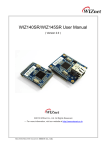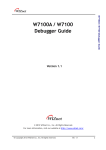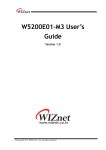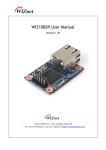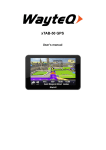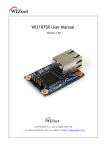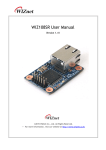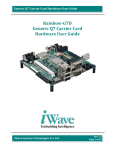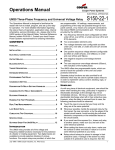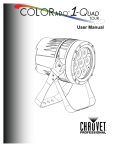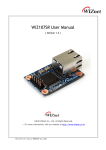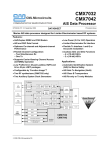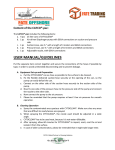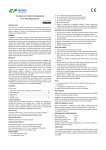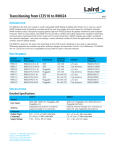Download EVB90363WEB User-Manual
Transcript
AppNote-FW90363web 3D HALL Sensor & Internet Interface EVB90363web (3D HALL Sensor Circuit and Internet Interface) USER Manual & Programming Guide Software Version v1.22 Firmware Revision History Revision Date V1.05 07.07.2011 Initial Version for EVB90363web V1.10 19.07.2011 communication speed optimized, proper SPI Timing, error detection in get(), pin filter removed, new RAM address addable. 01 V1.14 28.07.2011 DHCP and static IP improved, return message improved, added diagnostic functions, added bar graph output 02 V1.20 09.08.2011 Alpha Beta graphical output added, major Bug fix in Packet & Socket size and DHCP, Status Messages added for the MLX90363 added. V1.22 27.03.2012 Render mode and get data mode split into two different modes. New graphical output: 2D joystick. WIZ107IO Modules are now without PoE Connector. FW90363web-Manual Rev. 05 Changes Page 1 of 13 Doc. Rev. 03/04 05 DACOM West March/2012 AppNote-FW90363web 3D HALL Sensor & Internet Interface Table of Contents EVB90363web ................................................................................................................ 1 USER Manual & Programming Guide .......................................................................... 1 1. General Description .............................................................................................. 3 1.1 Key Features MLX90363 ................................................................................................ 3 1.2 Key Features WIZ107IO ................................................................................................. 3 2. Block Diagram MLX90363 / 3D Position Sensor IC ............................................ 4 2.1 Functional Description ..................................................................................................... 4 2.2 Supply options MLX90363 for 3.3V or 5V ....................................................................... 4 3. 3.1 4. 4.1 5. 5.1 6. 6.1 6.2 The WIZ107IO Module ........................................................................................... 5 Block Diagram WIZ107IO................................................................................................ 5 Webserver Module ................................................................................................ 6 Webserver Features ........................................................................................................ 6 Requirements ........................................................................................................ 7 Browser ........................................................................................................................... 7 Installation ............................................................................................................. 7 Power Supply .................................................................................................................. 7 PC Configuration, Network Setup ................................................................................... 7 6.2.1 6.2.2 7. 7.1 Using the Demo / Firmware .................................................................................. 8 Web Front-End ................................................................................................................ 8 7.1.1 7.1.2 7.1.3 7.1.4 7.1.5 7.1.6 7.1.7 7.2 8. Network setup by DHCP (default) ......................................................................................... 7 Manual Network setup without DHCP use ............................................................................ 8 Displaying the Measurements ............................................................................................... 8 Sample Size .......................................................................................................................... 9 The 3D- and Bar-Graph output (XYZ) ................................................................................... 9 The Alpha- / Beta- Pointer Instrument ................................................................................... 9 The Table output ................................................................................................................. 10 The MLX90363 Memory ...................................................................................................... 10 The WIZ107IO Configuration .............................................................................................. 12 Firmware Update ........................................................................................................... 12 Disclaimer ............................................................................................................ 13 FW90363web-Manual Rev. 05 Page 2 of 13 DACOM West March/2012 AppNote-FW90363web 3D HALL Sensor & Internet Interface 1. General Description The EVB90363web consist of two parts: The MLX90363 3D-Hall sensor IC assembled on a small EVB for universal use and easy access. The Internet-Gateway-Module WIZ107IO with a dedicated Webserver running on it for configuration (EEPROM) The MLX90363 senses the absolute position of a magnet moving above it. It enables the design of non contactless joystick (3D), rotary (2D) and linear (1D) position sensors. The MLX90363 3D-HALL position sensor is sensitive to the 3 components of the flux density (BX, BY & BZ) applied to the IC using Integrated Magneto Concentrator (IMC). The WIZ107IO is a small Module based on the W7100A Hardwired TCP/IP 4in1 SoC integrating an 8051 MCU + Hardware TCP/IP engine and Ethernet-MAC & -PHY. There are many open-source projects available and here it is used as Sensor (SPI) to Internet Gateway and Webserver. Source-Code is available with this EVB. A block diagram of the EVB90363web is shown below. 1.1 Key Features MLX90363 TriaxisTM Hall technology - absolute 3D position Simple & robust magnetic design 14 bit digital X, Y, Z or Alpha + Beta out Full duplex SPI protocol for EEPROM read & write Trigger pulse for synchronized parallel readout and speed calculation possible RAM readout for diagnostic and SIL ready Power supply range: 3.3V or 5V Operating temperature range: –40° C to +150°C Single & Dual Die - SO8 & TSSOP16 Package 1.2 Key Features WIZ107IO Hardwired TCP/IP SoC W7100A (64k Flash + 64k RAM) 4in1: 8051 MCU, TCP/IP, MAC, PHY (10/100MBit/s) UART I/F: TTL and RS232 8 universal IO (here software SPI) Integrated 3.3V low dropout voltage regulator FW90363web-Manual Rev. 05 Page 3 of 13 DACOM West March/2012 AppNote-FW90363web 3D HALL Sensor & Internet Interface 2. Block Diagram MLX90363 / 3D Position Sensor IC 2.1 Functional Description The MLX90363 is a monolithic magnetic sensor IC featuring the TriaxisTM Hall technology. Conventional planar Hall technology is only sensitive to the flux density applied orthogonally to the IC surface. The TriaxisTM Hall sensor is also sensitive to the flux density applied parallel to the IC surface. This is obtained through an Integrated Magneto-Concentrator (IMC ®) which is deposited on the CMOS die. The MLX90363 is sensitive to the three (3) components of the flux density applied to the IC (i.e. Bx, By and Bz). This allows the MLX90363 to sense any magnet moving in its surrounding and decode its position through an appropriate signal processing. Using its Serial Interface the MLX90363 can transmit a digital output (SP – 64 bits per frame). The MLX90363 is intended for Embedded Position Sensor applications (vs. Stand-Alone "Remote" Sensor) for which the output is directly provided to a microcontroller (Master) close to the magnetometer IC MLX90363 (Slave). The SPI protocol confirms this intent. The MLX90363 is using full duplex SPI protocol and requires therefore the separated SPI signal lines: MOSI, MISO, /SS and SLCK. 2.2 Supply options MLX90363 for 3.3V or 5V The MLX90363 can be supplied by 3.3V or 5V. We used 3.3V provided by the Network module here. Therefore at the MLX90363 the pin 1 (VDD) and pin 7 (VDEC) are shortcut on the EVB. To use the MLX90363 with 5V or in a standalone application can be done by braking the board apart on the pre-cut-line. This will also remove the 1-7 shortcut. Please see Datasheet of MLX90363, section 20. "Recommended Application Diagrams" as reference schematic also. FW90363web-Manual Rev. 05 Page 4 of 13 DACOM West March/2012 AppNote-FW90363web 3D HALL Sensor & Internet Interface 3. The WIZ107IO Module The Module is a general purpose interface for Serial-to-Ethernet Applications. It support some GPIOs, alternative ways for power supply and the serial interface in TTL and RS232. For power supply you can use 3.3V or 5V directly. Here the EVB90363 is attached as application by software implemented SPI to four GPIOs. 3.1 Block Diagram WIZ107IOA The WIZ107IO Module integrates the W7100A Hardwired TCP/IP Internet Chip plus low drop 3.3V Voltage regulator and an RJ45 MagJack. The low drop 3.3V regulator is used to supply 3.3V to the W7100A and 3.3V to the application. The MagJack is including the Auto MDI-X capable Transformer and two LEDs (green/yellow). You find more about the WIZ107IO Module and the schematic in the App.-Note here: http://www.dacomwest.de/de/ethermodul_wiz107io.htm FW90363web-Manual Rev. 05 Page 5 of 13 DACOM West March/2012 AppNote-FW90363web 3D HALL Sensor & Internet Interface 4. Webserver Module WIZ107IO Internet Interface 3.3V Boot En GND GND 5V EVB90363web 3D HALL Sensor 4.1 Webserver Features real-time 3D graphic and bar graph and/or spreadsheet output read MLX90363-RAM and read/write of -EEPROM for configuration High speed data-logging and save to file Source code available FW90363web-Manual Rev. 05 Page 6 of 13 DACOM West March/2012 AppNote-FW90363web 3D HALL Sensor & Internet Interface 5. Requirements 5.1 Browser There is no need for extra programs to be installed. You can use any Internet-Browser on any operating system you like. The Webserver uses Java-Script for the interactive user-interface and data output the Browser must support it and Java-Script must be activated. You gain access to the EVB by its SMBName "http://mlx90363/" or the static IP-Address 192.168.0.3 (default). 6. Installation 6.1 Power Supply EVB90363web: Power supply is 5V/300mA over EVB (recommended). Here also the internal 3.3V regulator of the WIZ107IO Module is used. You only need to connect 5V supply to Pad 5V and to Pad GND on the green PCB as shown in 4. Webserver Module. Options and detached shown in 6.2 Supply options MLX90363. 6.2 PC Configuration, Network Setup 6.2.1 Network setup by DHCP (default) Normally the module and your PC gets the network configured automatically by the local DHCP-Server most likely provided by your DSL-Router. The most important setting is the local IP-address of the module. If this setup is working it is not recommended to change the IP settings or switch off DHCP. If DHCP failed the EVB uses the static default IP 192.168.0.3 after 25 seconds. (5 requests times 5 sec.). In this case you have to manually set up your local client like shown below and described on next page. FW90363web-Manual Rev. 05 Page 7 of 13 DACOM West March/2012 AppNote-FW90363web 3D HALL Sensor & Internet Interface 6.2.2 Manual Network setup without DHCP use If you do not have DHCP or like to configure your Network manually you can do that in Windows 7 for example at your Network Card properties. The network card has to be changed from DHCP "Obtain an IP address automatically" to a static IP address as shown right. The default IP of the module is 192.168.0.3 so your static IP address must be from the same network but different. Format: IP: 192.168.0.x, sub mask: 255.255.255.0. Here we use 192.168.0.4 for example. Please see in 7.1.7 The WIZ107IO Configuration. If you add a serial RS232 cable to the Module to Pin 15 & 19 shown in 7.2 Firmware Update, you can see the "used IP address" in a terminal with 115kbaud 8N1 after a reset of the module. Now open a web browser and either type in the IP of the WIZ107IO (192.168.0.3) or the host name “MLX90363” in case of DHCP. Make sure Javascript is enabled in your browser. "Use this link to start: http://MLX90363/" 7. Using the Demo / Firmware The FW90363web firmware running on the WIZ107IO module contains the web server with the functionality dedicated to the MLX90363. The website uses JavaScript for all of its functionality and for the communication between the website and the WIZ107IO. Once the website is loaded, you should be able to start sampling immediately, by pressing the “sample continuously”. The website will then send out a request to the WIZ107IO to start sampling data, the request is then forwarded to the MLX90363. 7.1 Web Front-End Through the web front-end it is possible to read out the MLX90363 and display the measurements with a graphical interface or print them as a table. It is also possible to read out the RAM and read/write all important EEPROM parameters. 7.1.1 Displaying the Measurements The four top buttons are for starting and stopping measurement request from the MLX90363. "sample once" will request a set of measurements returned in one package and displayed. "sample continuously" will issue new requests, one after another, until stopped. "stop" will end the continuous requests. “clear” will erase all buffered measurements and will reset the package counting (for the “printing out packages”-option). FW90363web-Manual Rev. 05 Page 8 of 13 DACOM West March/2012 AppNote-FW90363web 3D HALL Sensor & Internet Interface 7.1.2 Sample Size Value sets are buffered twice, once in the W7100A and once in the web browser: "points plotted" is the amount of points plotted in the 3D-graph and pointer instrument. The browser buffers as many value sets as needed. "package size" defines the number n of value sets (counter, x, y, z) that are measured and then transferred at once. "delay time" is an additional pause between receiving one package and requesting the next one. One package request initiates n measurements with the MLX90363 (1.17ms per sample) that will be done without interruption. The data stored as one package in the W7100A is limited to 1000 value sets. The package size determines the number of measurements buffered before the W7100A sends out a TCP packet with the collected data. Rendering of the 3D-Graph always happens when a package is completely received and parsed, thus if the "points plotted" is less than the "package size", the difference will never be used. The delay time is not the actual one-way or round-way time of one communication. It is an additional delay if the collection needs to be less frequent. The actual update time depends mostly on the package size (the time it takes to collect the data plus transfer time). The update time is somewhere between 50ms (1 measurement) to 1200ms (1000 measurements). As mentioned the graphical interface is run by JavaScript without 3D graphic card support, thus it can slow down the sampling frequency and the frame-rate if the package size is a lot less than the points plotted. New incoming packages are not parsed before JavaScript has finished drawing all points (points plotted) therefore no new request is going out before finishing the rendering. To draw the highest point-density per time, or to sample as many values as possible of a fast changing magnetic field, the package size and plots drawn need to be high and about equal. For the best real time updates both values have to be low and equal. 7.1.3 The 3D- and Bar-Graph output (XYZ) The 3D- and Bar-Graph output (XYZ) For the 3D-Graph there are six buttons for rotating the perspective of the graph: up, down left and right. If you activate "sample continuously" and "<<" or ">>" the graph will slowly rotate automatically. The graph is rendered when the incoming package is completely parsed by JavaScript. To have all values, which are displayed on the 3D-graph, be in a continuous number space they are parsed from the 14 bit twos-complement representation returned by the MLX90363 to a 14 bit biased representation. On the output the values are displayed between +/-8192. On the left side there is additionally a bar graph for the very last sampled x-, y-, z-values. The data mode needs to be "x, y , z" for this render mode. 7.1.4 The Alpha- / Beta- Pointer Instrument The Alpha- / Beta- as Phasor and 2D-Joystick display For the use in an Joystick like Application the MLX90363 can internally (hardware) calculate the solid angle Alpha and Beta. For this the data mode has to be "alpha, beta". The setup and configuration of the equation is possible by EEPROM and is described in 7.1.6 The MLX90363 Memory. In comparison to the hardware based calculation it is also possible to switch to a software based calculation done by the Java-Script then (For this just switch back to the data mode "x, y, z"). Alpha and beta are calculated with the standard KA=1.4 and KB=1.4 and KT=1 and the mapping equivalent to a xyzMapping of "0". With that option you can also compare a "sample once" set of values (complete package) in 3D and as phasor and vise visa. Make sure that you have the 3D-flag in the EEPROM (address: 0x2a[3]) set to 0x1 if you want to use the 2D-Joystick render mode. Have it set to 0x0 if you want to use a 360 phasor just with alpha. FW90363web-Manual Rev. 05 Page 9 of 13 DACOM West March/2012 AppNote-FW90363web 3D HALL Sensor & Internet Interface 7.1.5 The Table output You can switch the display between the "graph" and a table output (“print out packages”) or activate both at the same time. The table is formatted and can easily be copied into EXCEL or any other spreadsheet. Every package and value set is counted. Values are not parsed and therefore retain in the original 14 bit twos-complement representation straight from the MLX90363. Therefore output values in the table look different from output in the 3D-Graph and values are between 0 and 16384 (8192 is a field strength of 0). 7.1.6 The MLX90363 Memory RAM and EEPROM of the MLX90363 can be read out, the EEPROM content can be change. Relevant information are displayed on the website. For the possible values of EEPROM parameters and their meanings refer to the MLX90363 data sheet. FW90363web-Manual Rev. 05 Page 10 of 13 DACOM West March/2012 AppNote-FW90363web 3D HALL Sensor & Internet Interface Any read or write command you send to the Module is documented in a status report on the right side. Here you get also feedback of diagnosis and status functions. With the button "clear status messages" you can delete the status report and reset the message counter. The counter is held in the EVB so you get non linear counting in case of multi browser access the same EVB at the same time. Missing counter values is normal in that case. With button "self diagnositic" you can trigger the internal diagnosis function of the MLX90363 and get the 4 Byte feedback. In the screenshot you see the status message feedback for read and write RAM and EEPROM and the diagnosis message. Especially when writing into the EEPROM, make sure the new values are possible and allowed. There will be status response for each memory address when writing: 10 20 30 31 32 33 46 48 51 52 54 57 253 no change in values, the write process is not initiated write process was initiated, all CRCs are ok, but no status returned CRC not correct after EE_WRITE CRC not correct after EE_READ_CHALLEGE CRC not correct after EE_CHALLENGE_ANS CRC not correct after NOP error erroneous key odd address success after NOP erase/write fail after NOP CRC erase/write fail after NOP challenge fail after NOP ERROR_FRAME_DETECTED In regular operation only status 10 and 51 should ever occur. All other statuses must be due to unknown bugs or connectivity issues. Please check your hardware if they occur. FW90363web-Manual Rev. 05 Page 11 of 13 DACOM West March/2012 AppNote-FW90363web 3D HALL Sensor & Internet Interface 7.1.7 The WIZ107IO Configuration Host name, IP and MAC address of the WIZ7100A can be change through the website, all though it is not recommended for this application. As you can see DHCP (default) provided a different network setup than the configurable static setup. 7.2 Firmware Update The W7100A is a free programmable 8051 MCU. You can upload a new Firmware by serial RS232 connection and a small PC-Software "WizISP". Please refer to the documentation and downloads provided by WIZnet. Link: WIZnet Internet MCU W7100A: http://www.wiznet.co.kr/Sub_Modules/en/product/Product_Line.asp?cate1=5 -> W7100A -> Downloads To prepare the serial connection to the PC you have to connect GND, RxD and TxD to the serial port of your PC. The RS232 level I/F is located at Pin 15 & 19 on the 2x11 pin header, see signal diagram below. Pin 3 and 4 are not usefull here as this is the serial interface in TTL level. To boot the W7100A in programming mode (start internal bootloader) you have to set "Boot En" to 3.3V on the three land-pads at the side of the module (Pin 1 and 2) and power on (5V) or reset the module. These land-pads you find in 4. Webserver Module. Now you can connect with the WizISP software and upload the new Firmware. Details are described in the WizISP documentation. FW90363web-Manual Rev. 05 Page 12 of 13 DACOM West March/2012 AppNote-FW90363web 3D HALL Sensor & Internet Interface 8. Disclaimer Devices sold by Dacom West GmbH are covered by the warranty and patent indemnification provisions appearing in its Term of Sale. Dacom West GmbH makes no warranty, express, statutory, implied, or by description regarding the information set forth herein or regarding the freedom of the described devices from patent infringement. Dacom West GmbH reserves the right to change specifications and prices at any time and without notice. Therefore, prior to designing this product into a system, it is necessary to check with Dacom West GmbH for current information. This product is intended only for evaluation use. The information furnished by Dacom West GmbH is believed to be correct and accurate. However, Dacom West GmbH shall not be liable to recipient or any third party for any damages, including but not limited to personal injury, property damage. loss of profits, loss of use, interrupt of business or indirect, special incidental or consequential damages, of any kind, in connection with or arising out of the furnishing, performance or use of the technical data herein. No obligation or liability to recipient or any third party shall arise or flow out of Dacom rendering of technical or other services FW90363web-Manual Rev. 05 Page 13 of 13 DACOM West March/2012















